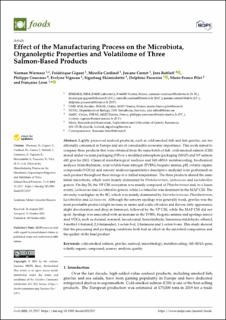| dc.description.abstract | Lightly preserved seafood products, such as cold-smoked fish and fish gravlax, are traditionally consumed in Europe and are of considerable economic importance. This work aimed to compare three products that were obtained from the same batch of fish: cold-smoked salmon (CSS) stored under vacuum packaging (VP) or a modified atmosphere packaging (MAP) and VP salmon dill gravlax (SG). Classical microbiological analyses and 16S rRNA metabarcoding, biochemical analyses (trimethylamine, total volatile basic nitrogen (TVBN), biogenic amines, pH, volatile organic compounds (VOCs)) and sensory analyses (quantitative descriptive analysis) were performed on each product throughout their storage at a chilled temperature. The three products shared the same initial microbiota, which were mainly dominated by Photobacterium, Lactococcus and Lactobacillus genera. On day 28, the VP CSS ecosystem was mainly composed of Photobacterium and, to a lesser extent, Lactococcus and Lactobacillus genera, while Lactobacillus was dominant in the MAP CSS. The diversity was higher in the SG, which was mainly dominated by Enterobacteriaceae, Photobacterium, Lactobacillus and Lactococcus. Although the sensory spoilage was generally weak, gravlax was the most perishable product (slight increase in amine and acidic off-odors and flavors, fatty appearance, slight discoloration and drop in firmness), followed by the VP CSS, while the MAP CSS did not spoil. Spoilage was associated with an increase in the TVBN, biogenic amines and spoilage associated VOCs, such as decanal, nonanal, hexadecanal, benzaldehyde, benzeneacetaldehyde, ethanol, 3-methyl-1-butanol, 2,3-butanediol, 1-octen-3-ol, 2-butanone and 1-octen-3-one. This study showed that the processing and packaging conditions both had an effect on the microbial composition and the quality of the final product. | en_US |

